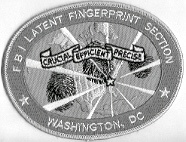
Collecting insignia from the Federal Bureau of Investigation since 1999.
This site is not officially sanctioned by the Department of Justice, The Federal Bureau of Investigation, The Louisville Metro Police Department, or any of their entities.
© Copyright 1999-2006. All Rights Reserved.
The Latent Print Unit conducts all work pertaining to the examination of latent prints on evidence submitted to the FBI Laboratory. Latent prints are impressions produced by the ridged skin on human fingers, palms, and soles of the feet. Unit examiners analyze and compare latent prints to known prints of individuals in an effort to make identifications or exclusions. The uniqueness, permanence, and arrangement of the friction ridges allow Unit examiners to positively match two prints and to determine whether an area of a friction ridge impression originated from one source to the exclusion of all others.
A variety of techniques, including use of chemicals, powders, lasers, alternate light sources, and other physical means, are employed in the detection and development of latent prints. In instances where a latent print has limited quality and quantity of detail, Unit personnel may perform microscopic examinations in order to effect conclusive comparisons.
In 1999 the FBI developed and implemented a new automated fingerprint system known as the Integrated Automated Fingerprint Identification System (IAFIS). Although IAFIS is primarily a ten-print system for searching an individual's fingerprints to determine whether a prior arrest record exists and then maintaining a criminal arrest record history for each individual, the system also offers significant latent print capabilities. Using IAFIS, a latent print specialist can digitally capture latent print and ten-print images and perform several functions with each. These include:
- Enhancement to improve image quality;
- Comparison of latent fingerprints against suspect ten-print records retrieved from the criminal fingerprint repository;
- Searches of latent fingerprints against the ten-print fingerprint repository when no suspects have been developed;
- Automatic searches of new arrest ten-print records against an unsolved latent fingerprint repository; and
- Creation of special files of ten-print records in support of major criminal investigations.
Using the IAFIS fingerprint search capability against data from the FBI Criminal Justice Information Services (CJIS) Division, which maintains the world's largest repository of fingerprint records, the Unit has made identifications in cases for which no known suspects were named for comparison purposes and in cases in which latent prints on crime scene-related evidence were not identified with suspects named in the investigation.
Personnel from the Latent Print Unit also form the nucleus of the FBI Disaster Squad, which renders assistance in identifying victims at disaster scenes. This squad may be deployed upon official request from the ranking law enforcement official at the scene, the medical examiner or coroner in charge of victim identification, the ranking official of a public transportation carrier, the National Transportation Safety Board, the Federal Aviation Administration, or the U. S. Department of State in instances of foreign disasters involving U. S. citizens. Since 1940, the Disaster Squad has responded to over 200 disasters worldwide and has identified over half of the victims by fingerprints or footprints.
Unit personnel use special techniques in the examination of fingers and hands of unknown deceased individuals to obtain identifiable prints. Automated searches of identifiable prints can be conducted in the IAFIS database, which contains over 36 million individuals' known fingerprints. If classifiable prints are obtained from all ten fingers, manual searches can also be conducted in the CJIS civil fingerprint file.
The Unit also provides training in all aspects of latent print work to local, state, federal, and foreign law enforcement personnel. In addition, the Unit conducts research to evaluate new technologies, procedures, and equipment.
Occasionally, in matters initiated by entities outside the FBI, the Unit will serve as a final authority when the authenticity, value, and/or identification of friction ridge impressions is questioned or challenged.
Source: Federal Bureau of Investigation
